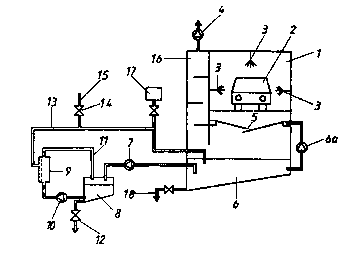Some of the information on this Web page has been provided by external sources. The Government of Canada is not responsible for the accuracy, reliability or currency of the information supplied by external sources. Users wishing to rely upon this information should consult directly with the source of the information. Content provided by external sources is not subject to official languages, privacy and accessibility requirements.
Any discrepancies in the text and image of the Claims and Abstract are due to differing posting times. Text of the Claims and Abstract are posted:
| (12) Patent Application: | (11) CA 2318807 |
|---|---|
| (54) English Title: | A PROCESS FOR TREATING CIRCUIT WATER FROM A PAINT SHOP |
| (54) French Title: | PROCEDE DE TRAITEMENT D'EAU DE CIRCULATION PROVENANT D'UNE INSTALLATION DE MISE EN PEINTURE |
| Status: | Deemed Abandoned and Beyond the Period of Reinstatement - Pending Response to Notice of Disregarded Communication |
| (51) International Patent Classification (IPC): |
|
|---|---|
| (72) Inventors : |
|
| (73) Owners : |
|
| (71) Applicants : |
|
| (74) Agent: | NORTON ROSE FULBRIGHT CANADA LLP/S.E.N.C.R.L., S.R.L. |
| (74) Associate agent: | |
| (45) Issued: | |
| (86) PCT Filing Date: | 1999-01-20 |
| (87) Open to Public Inspection: | 1999-08-05 |
| Examination requested: | 2003-12-02 |
| Availability of licence: | N/A |
| Dedicated to the Public: | N/A |
| (25) Language of filing: | English |
| Patent Cooperation Treaty (PCT): | Yes |
|---|---|
| (86) PCT Filing Number: | PCT/EP1999/000350 |
| (87) International Publication Number: | WO 1999038808 |
| (85) National Entry: | 2000-07-28 |
| (30) Application Priority Data: | ||||||
|---|---|---|---|---|---|---|
|
A method for treating circulating water from an enamelling line. The paint is
washed out of the outgoing air leaving the enamelling line with or without a
solvent and separated from the circulating water on a case by case basis. The
invention is characterised in that polyaspartamic acid is mixed with the
circulating water, preferably together with anionic surfactants. The invention
also relates to agents for the application of said method, comprising a
combination of polyaspartamic acid and anionic surfactants.
L'invention concerne un procédé de traitement d'eau de circulation provenant d'une installation de mise en peinture. Selon ce procédé, la peinture avec ou sans solvant, séparée de l'air d'échappement de l'installation de mise en peinture par lavage, est séparée de l'eau de circulation au moins selon le cas. L'invention est caractérisée en ce que l'on mélange de l'acide polyaspartique, de préférence avec des tensioactifs anioniques, à l'eau de circulation. L'invention concerne également des agents pour mettre en oeuvre ledit procédé, contenant une combinaison d'acide polyaspartique et de tensioactifs anioniques.
Note: Claims are shown in the official language in which they were submitted.
Note: Descriptions are shown in the official language in which they were submitted.

2024-08-01:As part of the Next Generation Patents (NGP) transition, the Canadian Patents Database (CPD) now contains a more detailed Event History, which replicates the Event Log of our new back-office solution.
Please note that "Inactive:" events refers to events no longer in use in our new back-office solution.
For a clearer understanding of the status of the application/patent presented on this page, the site Disclaimer , as well as the definitions for Patent , Event History , Maintenance Fee and Payment History should be consulted.
| Description | Date |
|---|---|
| Inactive: IPC expired | 2018-01-01 |
| Application Not Reinstated by Deadline | 2008-01-21 |
| Time Limit for Reversal Expired | 2008-01-21 |
| Deemed Abandoned - Failure to Respond to Maintenance Fee Notice | 2007-01-22 |
| Letter Sent | 2003-12-24 |
| Request for Examination Received | 2003-12-02 |
| Request for Examination Requirements Determined Compliant | 2003-12-02 |
| All Requirements for Examination Determined Compliant | 2003-12-02 |
| Amendment Received - Voluntary Amendment | 2003-12-02 |
| Letter Sent | 2001-10-25 |
| Inactive: Correspondence - Transfer | 2001-09-20 |
| Inactive: Correspondence - Transfer | 2001-09-20 |
| Inactive: Transfer information requested | 2001-09-04 |
| Inactive: Single transfer | 2001-07-25 |
| Inactive: Cover page published | 2000-10-25 |
| Inactive: First IPC assigned | 2000-10-22 |
| Inactive: Courtesy letter - Evidence | 2000-10-17 |
| Inactive: Notice - National entry - No RFE | 2000-10-11 |
| Application Received - PCT | 2000-10-06 |
| Amendment Received - Voluntary Amendment | 2000-07-28 |
| Application Published (Open to Public Inspection) | 1999-08-05 |
| Abandonment Date | Reason | Reinstatement Date |
|---|---|---|
| 2007-01-22 |
The last payment was received on 2005-12-21
Note : If the full payment has not been received on or before the date indicated, a further fee may be required which may be one of the following
Please refer to the CIPO Patent Fees web page to see all current fee amounts.
| Fee Type | Anniversary Year | Due Date | Paid Date |
|---|---|---|---|
| Basic national fee - standard | 2000-07-28 | ||
| MF (application, 2nd anniv.) - standard | 02 | 2001-01-22 | 2000-07-28 |
| Registration of a document | 2001-07-25 | ||
| MF (application, 3rd anniv.) - standard | 03 | 2002-01-21 | 2002-01-02 |
| MF (application, 4th anniv.) - standard | 04 | 2003-01-20 | 2002-12-30 |
| Request for examination - standard | 2003-12-02 | ||
| MF (application, 5th anniv.) - standard | 05 | 2004-01-20 | 2003-12-22 |
| MF (application, 6th anniv.) - standard | 06 | 2005-01-20 | 2004-12-22 |
| MF (application, 7th anniv.) - standard | 07 | 2006-01-20 | 2005-12-21 |
Note: Records showing the ownership history in alphabetical order.
| Current Owners on Record |
|---|
| AWARE CHEMICALS L.L.C. |
| Past Owners on Record |
|---|
| DIRK BOHNES |
| JOHANNES LINDEMANN |
| KARL MANDERSCHEID |